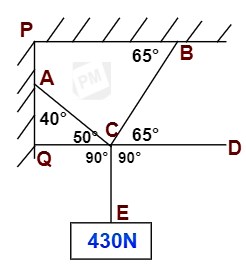Eg:
Calculate the tensional force developed in the wires AC & BC in the following drawing using Lami's theorem.
To find:
The tensional forces developed in the wires AC & BC
Calculation:
Let us draw a line QD parallel to the support PB as shown below. The line QD should pass through intersection point C.
As ∠ B = 65°, the ∠BCD will be equal to 65°
Note:
The alternate angles of a line cutting the two parallel lines are always equal to one another.
∠Q =90° as line QD is perpendicular to the support QP.
In triangle AQC,
∠C = [180°- ( ∠Q + ∠A )]
= [180°- ( 90° + 40° )]
= 50°
As an applied force is in the vertical axis, ∠QCE = ∠DCE = 90°
( As shown in the above drawing)
Now, let us draw a free-body diagram of forces as shown below.
∠ACE = [∠ACQ + ∠QCE]
= [ 50° + 90°]
= 140°
(As shown in the above drawing)
∠BCE = [∠BCD + ∠DCE]
= [ 65° + 90°]
= 155°
∠ACB = [360° - (∠ACE + ∠BCE)]
(As total value of a angle = 360°)
∠ACB = [360° - ( 140° + 155° )]
= 65°
By applying Lami's theorem,
T1 / sin155° = T2 / sin140° = 430N / sin65°
Where, T1 & T2 are the tensional forces in wires.
Therefore,
T1 = [(430N ➗ sin65°) x sin155°]
= [ (430N ➗ 0.906 ) x 0.422]
= [ 474.613N x 0.422 ]
T1 = 200.287N
T2 = [(430N ➗ sin65°) x sin140°]
= [ (430N ➗ 0.906 ) x 0.643 ]
= [ 474.613N x 0.643 ]
T2 = 305.075N
Tensional force in wire AC = T1 = 200.287N
Tensional force in wire BC = T2 = 305.075N
Thank you for going through these calculation steps❤. Have a good day 😄.














No comments:
Post a Comment